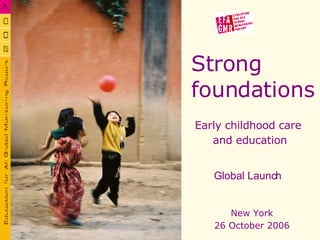
danses de bastons?
- 1. Strong foundations Early childhood care and education New York 26 October 2006 Global Launch
- 5. EFA: Where do we stand? Out of 125 countries, 47 have achieved the EFA goals. Countries showing the greatest progress are in the lowest scoring group Excludes many countries far from goals, e.g. those in conflict Total Far from EFA (EDI below 0.80) Intermediate position (EDI between 0.80 and 0.94) EFA achieved or close (EDI between 0.95 and 1.00) 50 28 2 18 2 1 3 6 2 2 11 4 8 19 47 15 6 17 3 4 1 1 Central/Eastern Europe Latin America/Caribbean N. America /West. Europe South and West Asia East Asia/Pacific Central Asia Arab States Sub-Saharan Africa
- 6. Education finance: A mixed picture Number of countries where public expenditure on education as % of GNP has: 41 65
- 8. More and more children are starting school Sharp increases in Grade 1 access in Sub-Saharan Africa and South and West Asia 1999 2004 80 100 120 140 Arab States Central/East. Europe N. America/ West. Europe East Asia/ Pacific Central Asia Sub-Saharan Africa Latin America/ Caribbean South/West Asia Gross intake rate in primary education (%)
- 9. Primary school participation on the rise Almost all countries with ratios below 85% in 1999 improved their situation 50 60 70 80 90 100 Sub-Saharan Africa Arab States South/West Asia Central/Eastern Europe Central Asia East Asia Pacific Latin America Caribbean N. America West. Europe Net enrolment ratios in primary education (%) 1999 2004
- 11. Who is out-of-school? Rural, poor, uneducated mother Out-of-school children by schooling experience
- 13. Quality: Growing number of learning assessments More governments are carrying out national assessments of learning outcomes and taking part in international exercises
- 20. ECCE: strong foundations “ Expanding and improving comprehensive early childhood care and education, especially for the most vulnerable and disadvantaged children” Rights UN Convention on the Rights of the Child Development Poverty reduction and the MDG health and education goals Education Future participation and achievement Equity Reducing social inequality
- 25. A public-private mix Across the developing world, the private sector plays a prominent role 45 34 76 Total 18 Central and Eastern Europe 1 8 11 North America/West. Europe 12 8 19 Latin America/Caribbean 1 2 1 South and West Asia 6 5 8 East Asia and the Pacific 8 Central Asia 13 4 3 Arab States 12 7 8 Sub-Saharan Africa High (67% to 100%) Medium (33% to 66%) Low (0% to 32%) Countries according to % of private pre-primary enrolment Region
- 26. Programmes for the under-3s Countries with at least one formal programme for children under 3 in 2005 (%) Many countries lack programmes addressing health, nutrition, care and education of the under 3s, a critical period in the child’s life
- 27. Regional trends in pre-primary A three-fold increase in pre-primary enrolments over 30 years More than 1 in 3 children now enrolled but huge regional differences Developed/transition countries Latin America/Caribbean East Asia/Pacific South and West Asia Arab States Sub-Saharan Africa
- 28. Recovering lost ground in transition countries Czech Republic Russian Fed. Ukraine Kyrgyzstan Romania Armenia Public spending cuts led to sharp enrolment declines after 1989 Now rising again, with the private sector becoming important Central Asia the exception
- 35. Financing ECCE: Finding the balance Funding is public and private Less than 10% of public education spending goes to pre-primary Even in OECD countries, parents’ share can run up to 60% Universal coverage + extra support to disadvantaged children (OECD) Income targeting Geographical targeting (remote areas,urban slums) Targeting specific groups: disabled, those in emergency situations How to allocate limited resources to children most in need? A universal policy with targeted spending on most disadvantaged?
- 36. ECCE: A low priority for donors Almost all donors allocate to pre-primary less than 10% of what they give to primary Bilateral donors give priority to centre- based programmes for children from age 3
- 39. EFA: An aid gap remains Current aid Aid in 2010 if 2005 pledges met Constant 2003 US$ billions Required each year to reach EFA
- 41. Contact Information EFA Global Monitoring Report Team c/o UNESCO 7, place de Fontenoy 75352 Paris 07 France [email_address] www.efareport.unesco.org